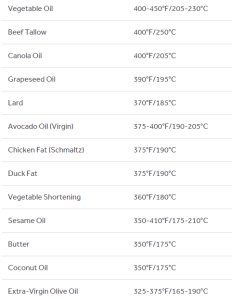Cooking With Fat – Smoke Point
Saturated, unsaturated, olive, canola, lard, butter…the list could go on. There are many different varieties of fats which can lead to some confusion but the main topic we’re going to discuss is: smoke point. The “smoke point” of a fat refers to the temperature at which a fat begins to smoke (pretty straight-forward). Learning how to understand those smoke signals is a crucial element to cooking.
While minimal smoking is okay, once you break past the smoke point you’re heading towards a danger zone. When the smoke point is surpassed, the fat starts to break down, releasing free radicals and a substance called acrolein, the chemical that gives burnt foods their taste and smell. Many unrefined oils or “virgin” oils contain minerals, enzymes, and other compounds that don’t fare well with heat. Although they are more nutritionally promoted, they tend to be more susceptible to rancidity (do to the low smoke point). For an oil to have a high smoke point, manufacturers use industrial-level refinement processes such as bleaching, filtering, and high-temperature heating to extract and eliminate those compounds. What’s left? A neutral-flavored oil with a longer shelf life and a higher smoke point.
So how do we know which oils to use for different cooking methods? As a general guideline it is suggested that we use oils with smoke points at or above 400°F (canola oil, vegetable oil, sunflower oil, peanut oil, etc.) when cooking at high temperatures. Below is a list of some of the more common cooking techniques and recommended oils for each.
Searing: The main goal is to heat meat as rapidly as possible to promote browning. Choose a neutral fat with a high smoke point like peanut, corn, or vegetable oil.
Sautéing: Smoking hot oil is not necessary for sautéing, therefore, virgin olive oil and other medium smoke point fats.
Stir-Frying: Wok cooking is fast and relies on a thin coating of super-hot oil to lubricate your food. With this cooking method you’ll want a really high smoke point oil (peanut or safflower) for the best (and safest) results.
Check the smoke points below to see if you’re using your oils appropriately. -SY


I have started using coconut oil in place of most other oils for anything I can. For instance on the rare occasion I make french toast on the stove top in a frying pan for breakfast. Also when I bake chicken in the oven. I place the coconut oil in the melted oil then roll in cracker crumbs then bake. If it calls for oil, I try coconut oil. Thought on this? Good? Bad?
When will I learn to read first post second? I place the CHICKEN in the melted oil before rolling in cracker crumbs. sorry
Hi there! Thank you for reading our blog, we appreciate the feedback! As far as coconut oil goes there’s a lot of controversy in the health field as to whether it’s “good” or “bad”. We are all told to try and stay away from saturated fats which is what coconut oil is made of. The difference in coconut oil is that it is made up of more “medium chain fatty acids” which are harder for our body to store as fat and easier to burn off then the long chain fatty acids that make up most saturated fats. First off, it is going to be dependent upon the type of coconut oil you’re using. Partially hydrogenated or refined coconut oil is going to be just as harmful as the other saturated fats (this is something you should check your label for). If you choose to continue the use of coconut oil we recommend doing so in moderation and we suggest that you use “virgin coconut oil” (this should also be on the label). Virgin coconut oil is extracted from the fresh fruit without the high temperatures and chemicals making it more likely to still have its antioxidant properties. However, overall, we would recommend using primarily the monounsaturated fatty acids such as extra virgin olive oil or canola oil! Hope this answers your question! Thanks again for your feedback! -SY